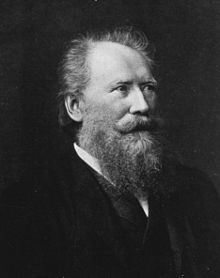Karl Joseph Eberth
Karl Joseph Eberth , also Carl Joseph Ebert (born September 21, 1835 in Würzburg , † December 2, 1926 in Berlin-Halensee ), was a German anatomist , pathologist and university professor .
Life
Karl Joseph Eberth was the son of an artist . After the early death of the father there was poverty in the family, Eberth contributed to the modest livelihood with art works ( silhouette ).
He studied medicine in Würzburg, among others with Rudolf Virchow , Franz von Leydig and Heinrich Müller . In 1859 he received his doctorate with a thesis on Trichocephalus dispar and worked as a zootomy prosector and scientific assistant to the zoologist and physician Albert von Koelliker , who taught physiology and anatomy in Würzburg . Most recently he was its deputy. Eberth completed his habilitation in 1862, then became a private lecturer and, from 1864 to 1865, a prosector of anatomy. In 1865 he moved to the University of Zurich as associate professor of anatomy and pathology , where he was appointed full professor of pathology, histology and embryology (at the Zurich Veterinary School) in 1869 . In 1881 he was appointed to the University of Halle , where he first represented comparative anatomy and histology, then all anatomy (from 1893) and finally pathological anatomy until his retirement in 1911 (from 1895). In 1884 he was elected a member of the Leopoldina . Eberth spent the last years of his life in Berlin.
power
The breadth of his scientific interests is reflected in the variety of his publications, some of which he has provided with masterful drawings by his own hand. He wrote z. B. as a parasitologist "About the whipworm " (1859) and "About nematodes" (1863). The fine structure of the liver , the heart muscles and the male reproductive organs or the growth of the fetal bones occupied him as an anatomist and histologist. He was able to show in 1872, "that the essence of diphtheria a mycosis and that bacteria carriers of the contagion are."
Eberth was the first person to describe nephroblastoma in children in 1872 .
"Representation of the mitoses in the regenerating corneal epithelium. CJ Eberth is one of the first to see mitosis and correctly interpret it before Walther Flemming. ”Georg Dhom, Geschichte der Histopathologie, p. 733
He was able to confirm histologically assumptions about a typhus pathogen . In 1880, together with Robert Koch , he described the abdominal typhoid pathogen named after him "Eberthella typhosa" ( Salmonella typhi ). The “Examination of the Sputum for Tubercle Bacilli ” (1891), a work on bacterial mycoses (1872) and the presumed identification of the causative agent of pneumonia ( Diplococcus pneumoniae ) were also important.
He dealt with the morphology of the lymphatic system ( lymph vessels of the heart) and turned from 1881 to the pathology of thrombosis (extracellular localization of the amyloid, 1880) and disruptive mechanisms of blood coagulation (1888).
Within his overall scientific work, the bacteriological work is of the greatest importance, whereby his hand-made "Bacteriological Wall Charts" (1891–1895) conveyed more precise knowledge to a broader public. From 1890 he acted (together with Goldschneider) as the editor of the journal “Advances in Medicine” in Berlin.
Fonts
- with A. Belajeff: About the lymphatic vessels of the heart. In: Arch Pathol Anat Physiol Klin Med. 1/1866, pp. 124-131.
- About nucleus and cell division. In: Arch Path (Berlin). 76/4 1876, pp. 523-541.
- The organisms in the organs in typhus abdominalis. In: Arch Path (Berlin). 1/1880, pp. 58-74.
literature
- Huldrych MF Koelbing : Eberth, Carl Joseph. In: Historical Lexicon of Switzerland . (2005).
- Eberhard J. Wormer : Syndromes of cardiology and their creators. Munich 1989, pp. 91-95.
- Robert Dumesnil, Hans Schadewaldt (ed.): The famous doctors. Cologne 1969, p. 235.
- Wilhelm Katner: Eberth, Karl. In: New German Biography (NDB). Volume 4, Duncker & Humblot, Berlin 1959, ISBN 3-428-00185-0 , p. 259 ( digitized version ).
- Rudolf Beneke: In memory of Karl Joseph Eberth. In: Münchner Medizinische Wochenschrift . Vol. 82 (1935), p. 1536 f.
- Rudolf Beneke: On Carl Josef Eberth's 80th birthday. Berlin 1915.
- L. Ribbert: Carl Joseph Eberth. In: German Medical Weekly . Vol. 31 (1905), p. 1511.
Web links
- Literature by and about Karl Joseph Eberth in the catalog of the German National Library
- Eberth at the University of Zurich
- Overview of Karl Joseph Eberth's courses at the University of Zurich (summer semester 1866 to winter semester 1880)
- Entry on Karl Joseph Eberth in the Catalogus Professorum Halensis
Individual evidence
- ↑ Reinhard Hildebrand: Rudolf Albert von Koelliker and his circle. In: Würzburg medical history reports. Volume 3, 1985, pp. 127–151, here: p. 136 ( Karl Josef Eberth ).
- ↑ Barbara I. Tshisuaka: Eberth, Karl Josef. In: Werner E. Gerabek , Bernhard D. Haage, Gundolf Keil , Wolfgang Wegner (eds.): Enzyklopädie Medizingeschichte. De Gruyter, Berlin / New York 2005, ISBN 3-11-015714-4 , p. 333.
| personal data | |
|---|---|
| SURNAME | Eberth, Karl Joseph |
| ALTERNATIVE NAMES | Ebert, Carl Joseph |
| BRIEF DESCRIPTION | German physician and university professor |
| DATE OF BIRTH | September 21, 1835 |
| PLACE OF BIRTH | Wurzburg |
| DATE OF DEATH | December 2, 1926 |
| Place of death | Berlin-Halensee |
